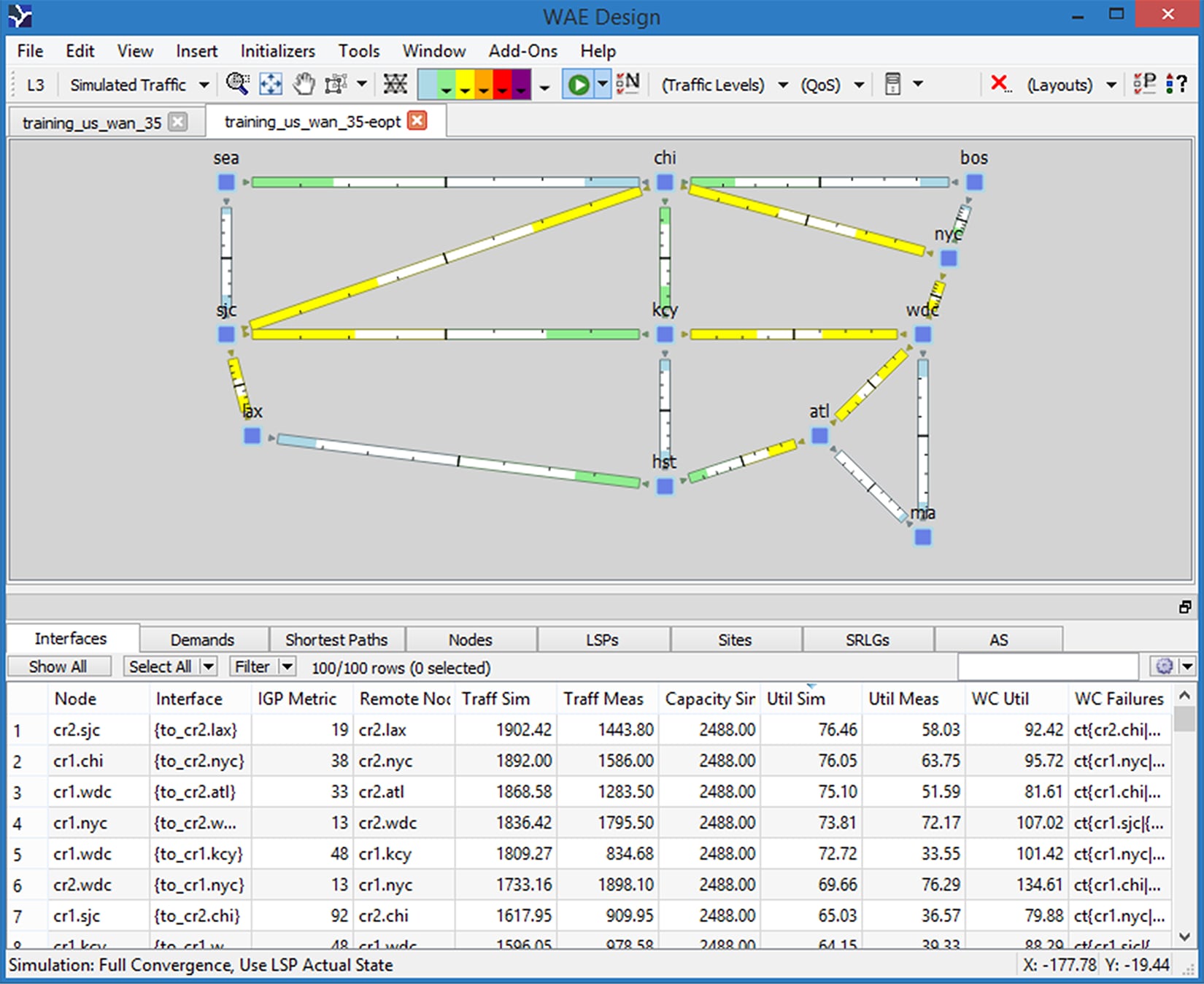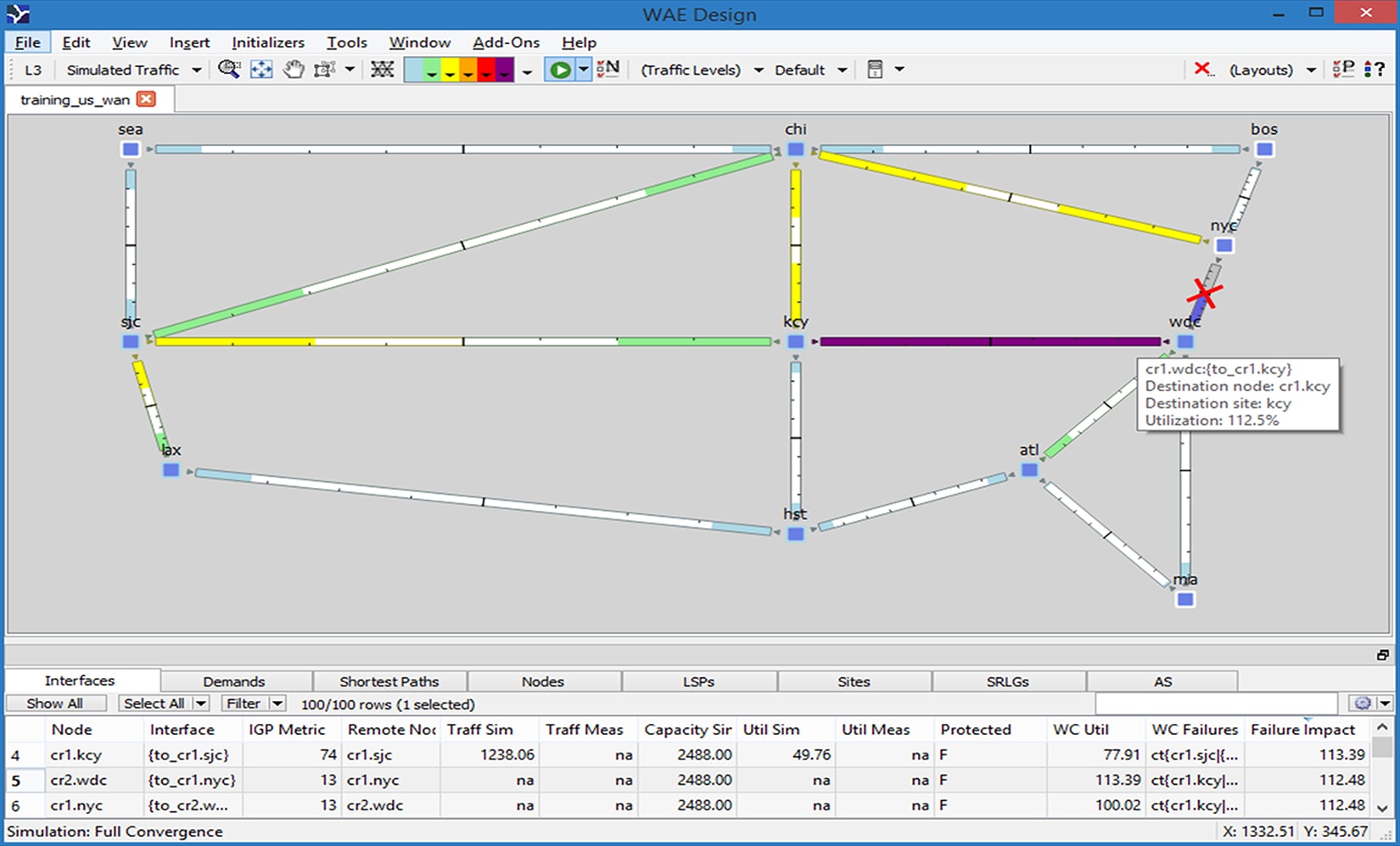Cisco WAN Automation Engine Data Sheet
Available Languages
Bias-Free Language
The documentation set for this product strives to use bias-free language. For the purposes of this documentation set, bias-free is defined as language that does not imply discrimination based on age, disability, gender, racial identity, ethnic identity, sexual orientation, socioeconomic status, and intersectionality. Exceptions may be present in the documentation due to language that is hardcoded in the user interfaces of the product software, language used based on RFP documentation, or language that is used by a referenced third-party product. Learn more about how Cisco is using Inclusive Language.
Cisco WAN Automation Engine (WAE) provides the tools for capacity planning, failure analysis, and traffic engineering, as well as analyzing network health and traffic trends.
Cisco® WAE is an integrated system for the designing, engineering, and planning of IP networks. It enables IT teams to explore the impact of failures and design changes on traffic flows, network performance, and reliability.
IP networks deliver a wide range of services, including cloud-based services, infrastructure as a service, unified communications and video collaboration services, and mobile services. With so many services dependent on this infrastructure, IT teams must focus on optimization of the network through capacity planning, traffic engineering, and improved network designs (greenfield or brownfield).
Cisco WAE meets these ongoing requirements through network planning and design tools that enable you to improve traffic distribution, identify vulnerabilities, and mitigate risk. Used worldwide by network planners and engineers, WAE’s streamlined workflow and highly interactive interface enables providers to accurately model the network and quickly accomplish planning tasks to improve network efficiency and operational costs (OpEx) under different network stress conditions.
Table 1. Top WAE features
| Feature |
Benefit |
| Collection |
Automated discovery of multivendor, multiprotocol network environments, including devices, topology, and traffic statistics. WAE continuously takes “snapshots” of the operating network and automatically adapts to changes without the need for user intervention to keep information current. |
| Simulation and modeling |
Visualization of IGP , MPLS LDP, MPLS Segment routing, RSVP-TE LSPs, Segment Routing LSPs, QoS, BGP, VPN, Multicast, and Layer 1 networks |
| Failure analysis |
Extensive reliability and resiliency analysis, including worst-case utilizations and latencies over a range of Layer 3 and Layer 1 failure states. |
| Demand deduction |
Cisco-patented Demand Deduction derives highly accurate end-to-end traffic flows from any available source, including traffic polling and NetFlow data. |
| Optimization |
Provide recommendations on LSPs and IGP metrics to balance traffic flow and optimize capacity |
| Capacity planning |
Provides recommendations on all three facets of Capacity Management - Network Engineering, Capacity Planning and Traffic Engineering |
WAE Collector provides a continuous process of taking operating network snapshots to capture changes without the need for user intervention and keeping backup information current. The network discovery and data collection process generates files used by both WAE Design and WAE Live. These files can include network configuration, visual layout, LSP and multicast routes, operational state of network objects, infrastructure elements, topology, and traffic statistics for network planning and analytics.
● Comprehensive: Supports multiple vendors (including Cisco, Juniper, Alcatel-Lucent, Nokia, Huawei) and multiple data sources
● Versatile: Supports major IP/MPLS network protocols including OSPF (v2, v3), IS-IS, BGP, QoS, IP Multicast, RSVP-TE, Layer 2 and Layer 3 VPNs, and LDP
● High performance: Discovers network objects and collects data from large IP/MPLS networks in minutes
● Automated: Captures the network topology, state and measurement changes using a scheduled collection process, ensuring no disconnect between the real network and the visualized, analyzed, or planned network.
Create and edit plans, including using Layer 1 topology, to build cost-effective Layer 3 networks. You can evaluate requirements for fastest routes and resilient Layer 1 circuit routes with routing and disjointness constraints.
● Know traffic utilization along any path, visually indicating the severity of traffic demands at any point in the network
● Comprehensive network representation of network elements and their properties for realistic simulations
● Use the network map (see Figure 1) to automatically receive detailed information in a table below it or select information in the table and see it represented graphically in the map
● Simple object creation and manipulation, including assignment of properties, for realistic network simulations
● Multiple backgrounds, such as schematic and geographic, offering multiple views of the same network, from high-level representations to street details
● Customizable layouts that can be shared, minimizing the amount of time it takes to upgrade plans
● Tools for automating visualization tasks, such as assigning site locations based on longitude and latitude, aligning sites, and segregating edge devices

Sample network diagram and table from WAE Design
WAE Design capacity management
Network capacity planning shortens project cycles while enabling capital and operational cost savings. WAE Design helps you accurately build out your network to remove bandwidth bottlenecks and better assess current and future traffic plans to ensure network resiliency.
WAE Design tools simplify capacity planning by enabling you to quickly and precisely perform the following tasks.
● Identify how failures (see Figure 2) affect the network and where bottlenecks would occur
● Determine inbound and outbound traffic demands within a site and from site to site, minimum/maximum latency, and path metrics
● Create growth plans based on traffic trends
● Use Simulation Analysis with user-specified failure scenarios to isolate worst-case impact on traffic utilization and latency
● Drill down into a site to see exactly what traffic types (for example, video versus data) cause congestion on a specific link

Impact of failed link between WDC and NYC causes congestion on link to KCY
WAE Design traffic engineering
Optimize the infrastructure through traffic load balancing while detecting and solving shortcomings in resiliency.
● Balance traffic loads across the least expensive links
● Provides a step-by-step sequence of routing configuration changes to move a network safely from an initial configuration to a prespecified final configuration congruent with optimization goals
● Explore the impact of moving traffic from one circuit to another
● Automatically identify how to optimize IGP metrics, L1 link metrics, and LSP paths
● Identify the shortest paths based on lowest total IGP values and change IGP metrics to observe impact on routed traffic and any issue the change might cause
● Change BGP routing between multiple ASs to maintain network integrity and service levels
Table 2. Standard protocol support: Key protocols
| Protocol | Title |
| Path Computation Element (PCE) Communication Protocol (PCEP) |
|
| Path Computation Element Communication Protocol (PCEP) Extensions for Stateful PCE |
|
| Path Computation Element Communication Protocol (PCEP) Extensions for PCE-Initiated LSP Setup in a Stateful PCE Model Through Cisco SR-PCE |
|
| RSVP-TE: Extensions to RSVP for LSP Tunnels |
|
| Traffic Engineering Extensions to OSPF Version 2 |
|
| (IS-IS) Extensions for Traffic Engineering (TE) |
|
| North-Bound Distribution of Link-State and Traffic Engineering (TE) |
|
| Segment Routing Architecture |
|
| Segment Routing and MPLS Data Plane |
|
| IS-IS Extensions for Segment Routing |
|
| IS-IS Traffic Engineering (TE) Metric Extensions |
|
| OSPF Extensions for Segment Routing |
|
| OSPF Traffic Engineering (TE) Metric Extensions |
|
| Path Computation Element (PCE) Communication Protocol Generic Requirements |
|
| A Path Computation Element (PCE)-Based Architecture |
|
| Path Computation Element (PCE) Communication Protocol (PCEP) |
|
| User-Based Security Model (USM) for Version 3 of the Simple Network Management Protocol (SNMPv3) |
|
| Version 2 of the Protocol Operations of the Simple Network Management Protocol (SNMP) |
|
| Cisco Systems NetFlow Services Export Version 9 |
WAE Design software licenses are based on user, application, technology, and device type. WAE has a Smart-enabled software subscription license. For more information, contact your Cisco account representative.
Cisco offers a wide range of services to help accelerate your success with Cisco WAE. The innovative Cisco Services offerings are delivered through a unique combination of people, processes, tools, and partners and are focused on helping you increase operational efficiency and improve your network control. Cisco Advanced Services use an architecture-led approach to help you align your network infrastructure with your business goals and achieve long-term value. Cisco WAE can be combined with Cisco SMARTnet® Service to help you resolve mission-critical problems with direct access at any time to Cisco network experts and award-winning resources. Spanning the entire network lifecycle, Cisco Services offerings help increase investment protection, optimize network operations, support migration operations, and strengthen your IT expertise. For more information, please visit https://www.cisco.com/go/services.
Flexible payment solutions to help you achieve your objectives
Cisco Capital makes it easier to get the right technology to achieve your objectives, enable business transformation and help you stay competitive. We can help you reduce the total cost of ownership, conserve capital, and accelerate growth. In more than 100 countries, our flexible payment solutions can help you acquire hardware, software, services and complementary third-party equipment in easy, predictable payments. Learn more.
● To discover more about Cisco WAE, please sign up on our DevNet site:
https://developer.cisco.com/docs/wan-automation-engine/#overview.
● Also available are detailed tutorials within Cisco WAE documentation:
www.cisco.com/c/en/us/td/docs/net_mgmt/wae/7-0-1/design/tutorials/b_Cisco_WAE_Design_Tutorials_701.html.
● To experience a Cisco WAE solution in the dCloud, please register at:
https://dcloud-cms.cisco.com/help/get_started_steps.
| New or revised topic |
Described in |
Date |
| Added WAE Collector section and revised Benefits section wording |
Features and benefits |
Sep 20, 2021 |